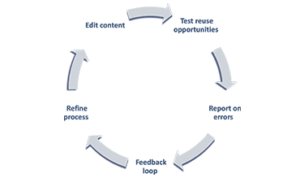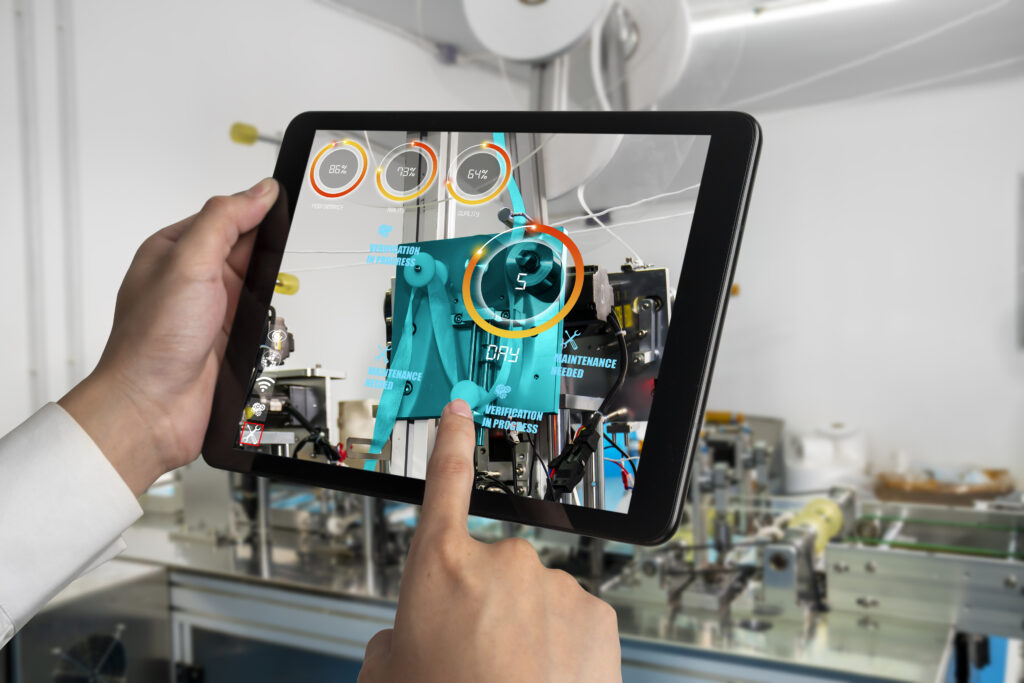Articles
Applications of VR/AR in Technical Communication: Hype or Future Technologies?
In our meetup on the future of technical communication, we explored the possibilities of digital realities in technical documentation. It’s a topic that has been gaining more attention in the context of technical documentation lately. We wonder how far future technologies are already ready for deployment and whether the trend will prevail and revolutionize technical documentation.
To understand the potential applications and how Virtual Reality (VR) and Augmented Reality (AR) can influence technical communication, we first clarify the terminologies and then provide examples of their usage and adoption. The possibilities of VR and AR in technical documentation are currently subject to varying evaluations.
Virtual Reality (VR) – Immersion into a Virtual World
Virtual Reality, or VR, is the representation of an apparent reality and its physical properties in a computer-generated virtual environment. Immersion into the virtual reality is achieved through a VR headset and, if applicable, additional data gloves equipped with tracking sensors. The technology responds to the user’s movements, creating an entirely new connection between the user and the content. Virtual Reality is already widely used today. The gaming industry is perhaps the most well-known example, where VR has been used and continuously improved since the 1990s. Virtual technologies are also employed in the healthcare sector for training purposes, pilots and astronauts undergo flight simulations, and in architecture, buildings can be simulated in a virtual world. In general, VR offers significant potential for the education and training sector.
Promising Opportunities in Technical Communication
In the industry, VR applications are used in the planning phase, visualization of work processes, and product control. VR thus offers promising possibilities for technical communication.
Prototyping: Products and processes that do not yet exist can be represented in a virtual world, viewed from all angles, and tested for errors. This helps companies save costs and time. For example, in the automotive industry, new models can be evaluated in a 3D world, providing developers with an early and realistic overall impression.
Production Processes: VR enables virtual simulation of production processes, leading to more efficient workflows and accelerated production. This can result in significant time and cost savings for companies during product development.
Training and Education: Virtual Reality offers a high potential in the field of training and education due to its interactive capabilities and spatial experiences. Employees can virtually operate machinery or practice work processes. VR is particularly suitable when real-world training is very expensive or carries a high risk of injury. Therefore, Virtual Reality applications provide companies with a scalable and cost-effective way to conduct training on industrial machines.
What’s the deal? Advantages and Disadvantages of Virtual Reality
The advantages of VR are evident and arise from numerous application examples. However, what are the disadvantages associated with this new technology?
In VR applications, information can be presented independently of the real world. Realistic planning with 3D visualizations of machines, testing functionalities, and simulating machine processes are significant advantages for technical communication. Dangerous situations and complex products can be easily simulated, offering innovative possibilities for training and education. VR enables location-independent, collaborative work of multiple employees in a virtual space.
Nevertheless, these advantages are counterbalanced by immensely high costs and the time required to create a virtual world. Additionally, the end devices themselves are very expensive. The cognitive overload caused by wearing a VR headset should not be underestimated, nor should the general danger of being immersed in an imperceptible reality. The adoption of VR applications presents technical documentation with entirely new requirements. Moreover, the required computing power for VR worlds poses significant challenges for both users and systems.
The lack of standardized CAD data, which allows machines to be simulated in the virtual world, also proves to be a stumbling block.
What is Augmented Reality? And where is it used?
A fusion of virtual reality and physical reality is referred to as mixed reality (also known as Augmented Reality or AR). In Augmented Reality, the real world is augmented with computer-generated objects. Using a mobile device, an additional layer of information is overlaid onto the real world. The AR system scans the real environment, identifying geometric surfaces and objects, allowing the digital object to be seamlessly integrated into the real world.
Today, there are numerous applications of Augmented Reality. AR product configurators enable users to customize products in real-time and view them as 3D models in their space. Event organizers can create new experiences for visitors using AR. In architecture and landscaping, AR finds its application by virtually placing buildings and plants in space. Augmented Reality is particularly well-suited for interior design and furniture. Customers can see how objects will look in their space. Additionally, there are many other applications in training, navigation, shopping, gaming, social media, etc.
Augmented Reality in Technical Communication
Augmented Reality opens up many new possibilities for technical documentation. Displaying additional information on real objects can be very useful for accomplishing complex tasks. Suitable industrial use cases include production, manufacturing, maintenance, service and repair, as well as training and education.
Users no longer need to switch between a machine and technical documentation. Through AR glasses, information can be directly transferred into the environment, and users have their hands free to operate machines or devices. The information is displayed in real-time, dynamically, and tailored to the user’s current situation. Such information can include components or safety instructions, live translations of content, or direct ordering of missing materials or spare parts. For example, a service technician can be guided step-by-step through maintenance via an AR solution or undergo training on an unfamiliar machine.
Advantages and Disadvantages of Augmented Reality
AR differs from VR in the degree of virtuality, and this is also where its advantage lies, as a lower degree of virtuality results in higher user acceptance. Smartphones and tablets are widespread, which has led to many AR applications in the consumer market. The possibilities with AR are almost limitless, promising scalability and cost savings. Even end-users themselves could use AR solutions to perform minor repairs or problem diagnoses.
However, unlike VR, AR applications can only be applied on-site directly. Therefore, it makes sense for service technicians to use AR glasses to have both hands free. Yet, the end devices are still quite expensive, and the development and effort for technical documentation are very high.
Where does VR/AR stand in Technical Communication today?
Are Virtual Reality and Augmented Reality applications just a hype in the industry, or will they develop into a fixed component? We are convinced that both VR and AR applications can offer significant value in Technical Communication.
To create the right virtual experiences for users, there must be an appropriate data foundation. An intelligent, topic-based provision of all company information is crucial. Data needs to be structured and made available in an automated manner. We believe that the breakthrough of VR/AR must first be achieved with end-users to spread corresponding applications and create new formats. For widespread adoption, costs must initially decrease, and technologies must become generally available. Currently, the following prerequisites are crucial for implementing VR/AR in Technical Documentation: goal definition, target audience analysis, identification of a suitable use case, and a cost-benefit analysis.
We see great potential, especially in AR applications, for Industry 4.0 and the future of Technical Documentation.
Subscribe to the free newsletter from PANTOPIX.
We will gladly keep you informed regularly about new articles.

From Legacy Systems to DITA: Case Studies in Successful Migration
This article explores real-world insights and lessons learned from successful migration projects, based on two case studies facilitated by PANTOPIX.

Knowledge Graphs and Large Language Models: the perfect combination!
Out-of-the-box solutions for RAG systems are becoming increasingly widespread. They promise to make a company’s knowledge accessible from documents such as PDFs or Word files using Large Language Models (LLMs) in the form of a chat.

Semantic layers of the Product Information Management Systems (PIM)
Companies rely on Product Information Management (PIM) systems to create, manage, and distribute product information across various channels. We can offer PIM systems software solutions for our industrial clients.
Contact us
Maraike Heim
Head of Marketing
- maraike.heim@pantopix.com

